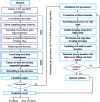Artificial Humming Bird Optimization-Based Hybrid CNN-RNN for Accurate Exudate Classification from Fundus Images
- PMID: 36241944
- PMCID: PMC9984609
- DOI: 10.1007/s10278-022-00707-7
Artificial Humming Bird Optimization-Based Hybrid CNN-RNN for Accurate Exudate Classification from Fundus Images
Abstract
Diabetic retinopathy is the predominant cause of visual impairment in diabetes patients. The early detection process can prevent diabetes patients from severe situations. The progression of diabetic retinopathy is determined by analyzing the fundus images, thus determining whether they are affected by exudates or not. The manual detection process is laborious and requires more time and there is a possibility of wrong predictions. Therefore, this research focuses on developing an automated decision-making system. To predict the existence of exudates in fundus images, we developed a novel technique named a hybrid convolutional neural network-recurrent neural network along with the artificial humming bird optimization (HCNNRNN-AHB) approach. The proposed HCNNRNN-AHB technique effectively detects and classifies the fundus image into two categories namely exudates and non-exudates. Before the classification process, the optic discs are removed to prevent false alarms using Hough transform. Then, to differentiate the exudates and non-exudates, color and texture features are extracted from the fundus images. The classification process is then performed using the HCNNRNN-AHB approach which is the combination of CNN and RNN frameworks along with the AHB optimization algorithm. The AHB algorithm is introduced with this framework to optimize the parameters of CNN and RNN thereby enhancing the prediction accuracy of the model. Finally, the simulation results are performed to analyze the effectiveness of the proposed method using different performance metrics such as accuracy, sensitivity, specificity, F-score, and area under curve score. The analytic result reveals that the proposed HCNNRNN-AHB approach achieves a greater prediction and classification accuracy of about 97.4%.
Keywords: Artificial hummingbird algorithm and exudates; Convolutional neural network; Fundus image; Recurrent neural network.
© 2022. The Author(s) under exclusive licence to Society for Imaging Informatics in Medicine.
Conflict of interest statement
The authors declare no competing interests.
Figures












References
-
- Auccahuasi W, Flores E, Sernaque F, Cueva J, Diaz M, Oré E. Recognition of hard exudates using Deep Learning. Procedia Computer Science. 2020;167:2343–2353. doi: 10.1016/j.procs.2020.03.287. - DOI
-
- Bilal A, Sun G, Mazhar S, Imran A, Latif J: A Transfer Learning and U-Net-based automatic detection of diabetic retinopathy from fundus images. Computer Methods in Biomechanics and Biomedical Engineering: Imaging & Visualization. pp.1–12, 2022
-
- Anitha GJ, Maria KG: Detecting hard exudates in retinal fundus images using convolutional neural networks. In 2018 International Conference on Current Trends towards Converging Technologies (ICCTCT) (pp. 1–5). IEEE, 2018
-
- Benzamin A, Chakraborty C: Detection of hard exudates in retinal fundus images using deep learning. In 2018 Joint 7th International Conference on Informatics, Electronics & Vision (ICIEV) and 2018 2nd International Conference on Imaging, Vision & Pattern Recognition (icIVPR) (pp. 465–469). IEEE.2018
MeSH terms
LinkOut - more resources
Full Text Sources
Medical

